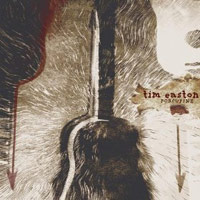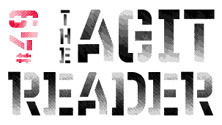
My Electric Family
Drag City
For Annabel Alpers, the sole idealist behind New Zealand’s Bachelorette, the kiwi-pop of her ancestors holds little weight in her compositions, though much of her second album, and first for Drag City, My Electric Family, could be re-imagined as provincial hits for Christchurch rag-tags. That’s indicative of Alpers’ scope in songwriting—plug-in pop for any arrangement, any occasion—as she’s constantly skirting a nether region where the organic and electric coexist in symbiotic harmony. Before even scratching the surface of that almost-synergy in her songs, it can be heard in her voice, which is detached but angelic, robotic but fleshy, cooing into an ice-fortress. Part Björk preciousness, part android love.
Compared to her previous record, the sparse Isolation Loops, My Electric Family, while still written as a calculated study of electro-tropes, has human warmth that is wholly inviting thanks to the album being dressed with a full band. Even among the strict genre tracks, found with the shuffling country twang of “Instructions for Insomniacs” and the rococo disco of “Mindwarp,” Alpers finds a way to meld lap-steel with spiraling synths or zither with mirror-ball sheen. There’s a line between such disparate traits, a juxtaposition that rarely sounds forced and instead blossoms into majestic pop events. Alpers’ sci-fi experiment is best represented on “Dream Sequence,” in which she sings about exploring the “nuero-pathways” of her brain while familial organ presets waltz in analog minimalism before welcoming a chorus of regal brass. “Technology Boy” finds the same Kraftwerkian sterility, only layering the second half with a ply of ethereal vocals, lending a certain verisimilitude that renders her future-world completely tangible. Like her celestial contemporaries—the aforementioned Björk, Joanna Newsom, Kate Bush and Laurie Anderson—if only because of her quirky contraptions, Annabel Alpers’ Bachelorette will likely be received with xenophobic ears, that is until the rest of us make the effort to learn her language.
Kevin J. Elliott
MP3: “Mindwarp”

Amatoria
Eighteenth Street Lounge
Since somewhere around the turn of the century, Federico Aubele began making a name for himself as a new breed of Argentinean musician, adeptly inserting the musical heritage of Buenos Aires amongst downtempo beats and dub grooves. It made for a couple of arresting records, 2004’s Gran Hotel Buenos Aires and Panamericana from 2007. Though overlooked in comparison, those records were the Latin America equivalent of Blue Lines and Dummy, juxtaposing not so dissimilar musical strains in a way so natural that it was surprising no one had thought of it before. Joined by a bevy of guest singers, Aubele joined traditional bolero and tango sounds with deep bass dubs, carving out his own niche in the process.
Aubele’s latest album, Amatoria, is nothing so shocking—except considering it in the context of his other work. On this record, he abandons most modern influence, instead drawing his inspiration from more traditional sources. While one may notice some slight-of-hand resembling his old ways, especially on “Luna y Sol” and “Te quiero a ti,” here Aubele presents himself as a straightfaced singer-songwriter, sticking to his Latin heritage and its romance language. Essentially stepping out from behind the curtain, Aubele doesn’t yet have the chops to pull off a dozen songs, and Amatoria wanes fast as the record progresses. Though he’s perhaps following his own muse, it has led him astray and to making a record beneath him.
Stephen Slaybaugh

La Llama
Stones Throw
How did Guillermo Scott Herren (with cohorts Eva Puyuelo Muns and Roberto Carlos Lange) manage to create a record that sounds so stunningly modern and yet clearly evokes another time and place? Herren and company’s new label, Stones Throw, call this a Catalan acid-folk project, and Herren himself says that it’s specifically about creating songs in the Catalan language that he and Muns share. Doing so involved visiting some historical recordings, and the resulting atmospherics lend an organic, timeless feel to the music. (Understanding what’s so special about the Catalan language and how its history and politics might inform La Llama probably requires a visit to Wikipedia.)
Guitars strum a little here and there, while found noise (mostly from Herren’s Bowery apartment, where the album was recorded, we assume) creaks and tinkles in the corners. But what we mostly hear is the juxtaposition of harmonized Catlan vocals and percussion of every sort imaginable. Especially when Muns takes the lead, much of it is remniscent of Juana Molina’s more ambient work.
Despite his efforts to keep this work seperate from Prefuse 73, it seems Herren can’t keep that familiar backbeat from creeping in here and there. It’s not a bad thing, though, as the more precussive tracks (“El Colleccionista” and “Untitled”) are well-placed to keep you from completely floating away into the atmospherics. As experienced Savath & Savalas listeners would expect, there’s little in the way of verse-chorus-verse songwriting here. If anything, it seems more like verse-verse-verse-bridge-repeat. That repetition may be the record’s one weakness, an affliction that also carries over from Prefuse 73. Nevertheless, La Llama manages to be both musically and technically intriguing at the same time, while also creating stunning beauty. It’s not hard to imagine spending a sun-drenched Saturday afternoon adrift in these gently told folk tales.
Matt Slaybaugh

Veckatimest
Warp
It’s rather impossible to review Grizzly Bear’s Veckatimest subjectively, given that it’s been available to the general public a solid three months before the actual physical release and many have already judged the album as another “event” record, positing the Brooklyn quartet to the role of generational auteurs. Yellow House was certainly expansive, ambitious and executed with a fine-toothed calm that envisioned larger peaks and valleys. But that album existed in shadow and fog. The lead track on Veckatimest, “Southern Point,” exposes Grizzly Bear from the outset, packed with proggy acoustic flares, hushed woodwinds and majestic strings, the song is a mid-70s Yes quest (think “South Side of the Sky”) compared to Yellow House. That new found light extends to “Two Weeks,” where all the symphonic pop pleasures of Brian Wilson are refashioned to fit the band’s melancholic psychedelia. Even as Grizzly Bear has made a decidedly transparent record in Veckatimest, as found on “Cheerleader,” it’s not so much that they are fully exposed but rather allowing a peek down a different hallway in their labyrinth of smoke and mirrors. “Cheerleader” is barely there were it not for the voices and the spacious reverb. It’s these precious elements coalescing in illusion that tend to be Grizzly Bear’s greatest gift.
Unfortunately Veckatimest’s middle section sounds composed of afterthoughts, loose structures that are held together with the group’s ardent harmonies, but tend to suck the life from any motion formed during their thrilling first act. Still, the Ed Droste/Dan Rossen nexus is a dramatic balance of the baroque and the opaque, illuminating arrangements and lulling dreamworld ambience. and nowhere is that partnership more evident than on “While You Wait for the Others,” as if those dour moments were leading up to this late album salvation. While Veckatimest may not outshine the hyperbole it has been given, Grizzly Bear have certainly made a record that should be showered with superlatives, as there are few groups operating in this orchestral pop spectrum that can pull it off with such exquisite cool and wonder.
Kevin J. Elliott

The Loud Wars
Vagrant
It’s been almost two years since we last heard anything from Edwardsville-based band So Many Dynamos, but that doesn’t mean they haven’t been busy. They’ve put in more grudge-work than many up-and-coming bands, and it finally seems to be paying off now that they’ve signed on to major label Vagrant.
If their blog, or Wikipedia for that matter, holds any shred of truth, their lives have been just as frenzied as their music, playing out like a really shitty tarot card reading: falling victim to a robbery that left them without musical equipment, then a car crash that left them without their tour van—all in the same year. If their life really is this chaotic, it’s a good thing they’re taking notes (via their meticulously-detailed blog), because this chaos that permeates their lives, and the ability to master that into music, is what got them noticed in the first place. And it’s the formula and genre they continue to refine on The Loud Wars.
The Loud Wars follows the So Many Dynamos formula—frenzied guitars, drum loops and plenty of danceable post-rock music—but this time around, it’s a bit more polished and inviting. The album attempts to explore “the physics and metaphysics of sound,” hence the title, which makes sense, because if anybody can explore the fine line between sounding polished and simply being loud, it should be the Dynamos, a band that has mastered the art of controlled chaos. The album certainly explores this diatribe, ebbing and flowing loudly throughout and keeping listeners on their toes as it progresses. Wars starts with a bang, with the frantic but catchy “Artifacts of Sound,” and hits highs and lows along the way, ending blandly with the ambitious, but drawn-out, “The Formula.”
Regardless of the outside underlying inspirations or issues the Dynamos may have faced along the way, Loud Wars has the potential to bring around lots of new fans for the band—a welcome success for a hard-working band with such a specific niche.
Jennifer Farmer

Porcupine
New West
Though (in full disclosure) Tim Easton may be an old friend, it hasn’t kept me from questioning his choices in musical direction in the time since the Haynes Boys disbanded. After a self-released solo venture, Special 20, he hooked up with New West to release a series of questionable albums, records that (to varying degrees) often covered up nuggets of good songs in production and gloss.
So the idea of returning to the studio and engineers who worked on Special 20 seems a little too obvious—an attempt at capturing something once loss by a means that would definitely be cliche were Tim a bigger name. To get to the grist of the matter though, that doesn’t really make much difference when the results are so convincing. But while producers Brad Jones and Robin Eaton may have done right by Tim and his songs, it’s also the performances here that are the real pudding. Easton exhibits more soul than he has heretofore, particularly on“The Young Girls,” where he builds a simple blues stomp into gospel-tinged revelation, and elsewhere (“Northbound”) strikes a swampy groove not unlike CCR. One might be tempted to mention something about Easton returning to his roots, but this album is not about that. It’s about a couple old friends helping him make an album that transcends everything he’s done before.
Stephen Slaybaugh
ALBUM REVIEWS
Romanian Names
Jarvis Cocker, Further Complications
Pontiak, Maker
White Rabbits, It's Frightening
Akron/Family, Set 'Em Wild, Set 'Em Free
Maximo Park, Quicken the Heart
The Field, Yesterday and Today
New York Dolls, 'Cause I Sez So
Crystal Method, Divided By Night
Ear Pwr, Super Animal Brothers III
Tyvek, Tyvek
Pink Mountaintops, Outside Love
Bob Dylan, Together Through Life
Tara Jane O'Neil, A Ways Away
Depeche Mode, Sounds of the Universe
